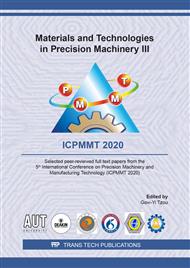p.12
p.21
p.27
p.33
p.41
p.48
p.56
p.64
p.74
Modelling of Neutral Line Parameter for Sheet Metal Stamping and Roll Forming Processes
Abstract:
The blank development of sheet metal for the stamping and the roll forming processes is crucial for the dimensional accuracy of the products. The neutral line parameter is the indicator to present the thinning phenomenon at the bending corners of the products. The basic assumption of the neutral line position is the surface that the sheet metal remains un-deformed after the stamping or the roll forming process. The conventional determination method of the neutral line position is based on the zero strain position through the thickness direction of the blank. In this paper, a different neutral line factor calculation method based on the mean profile length was proposed to find the neutral line factor, which is directly related to the profile length and more precise for the bland development calculation. A cross sectional profile was obtained after the forming process and the mean profile length of the upper and the lower surface was obtained. The ratios of the bending radius to the sheet thickness were calculated using the FEM simulation. A neutral line equation was proposed considering the material mechanical properties and the bending tool parameters. The initial blank width was compared to the forming result of the CAE simulation to validate the neutral line model. This model is able to take into consideration of the thinning effect at the entire bending zone of the metal forming without the assumption of the uniform thinning and is more accuracy for the blank width calculation.
Info:
Periodical:
Pages:
41-47
Citation:
Online since:
October 2020
Authors:
Keywords:
Price:
Сopyright:
© 2020 Trans Tech Publications Ltd. All Rights Reserved
Share:
Citation:


